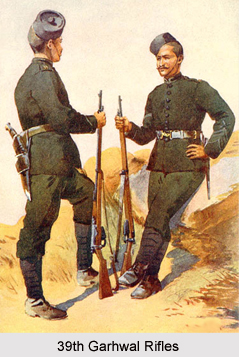 The 39th Garhwal Rifles was an infantry regiment that was developed by the British East India Company, in 1887. The unit served till the year 1922. The regiment was a part of the Bengal Army of the Bengal Presidency. The armed force of the province of Bengal was one of the main Presidency Armies in British India. The 39th Garhwal Rifles was also included as a part of the Bengal Command. Later the unit came under the authority of the British Indian Army. It was also known as the 39th (Garhwali) Bengal Infantry.
The 39th Garhwal Rifles was an infantry regiment that was developed by the British East India Company, in 1887. The unit served till the year 1922. The regiment was a part of the Bengal Army of the Bengal Presidency. The armed force of the province of Bengal was one of the main Presidency Armies in British India. The 39th Garhwal Rifles was also included as a part of the Bengal Command. Later the unit came under the authority of the British Indian Army. It was also known as the 39th (Garhwali) Bengal Infantry.
History of 39th Garhwal Rifles
The 39th Garhwal Rifles infantry was formed in the year 1887 as the Aligarh Levy. The unit was dissolved in 1888 after being degraded in the Rawalpindi Review. Later in 1891, the 39th (The Garhwali) Regiment of Bengal Infantry was re-raised from the 2nd battalion 3rd Gurkha Rifles. The battalion was granted the statute title of Rifles in the year 1892. A second battalion of the regiment was formed in 1901.
Military Operations of 39th Garhwal Rifles
The infantry regiment fought in the First World War, the 2 battalions of the 39th Garhwal Rifles became a part of the Garhwal Brigade, 7th (Meerut) Division and served on the Western Front. The unit later participated in the Mesopotamia Campaign. Subsequently, 2 further battalions of the regiment were formed for service in World War I. The troops of the regiment later served in the campaign to Waziristan from 1919 to 1920.
Development of 39th Garhwal Rifles
The army unit was re-designated as the 39th Royal Garhwal Rifles in 1921. After World War I, the British Government regrouped and reorganised the infantry structure of the British Indian Army. Many multi battalion regiments of 4 to 6 battalions were raised by merging the single battalion infantry units. In the year 1922, the 39th Garhwal Rifles served as the only non-Gurkha Indian infantry regiment without any amalgamation. The unit was named as 18th Royal Garhwal Rifles with 3 active battalions; while the 4th battalion was designated as the 10th training battalion.
Designations of 39th Garhwal Rifles
The 39th Garhwal Rifles held a many titles through out its existence during the restructuring of the British Indian Army, like the other regiments. These are listed below-
* Aligarh Levy in 1887
* 2nd Battalion, 3rd (Kamaon) Gurkha Regiment in 1887
* 39th (Garhwali) Bengal Infantry in 1890
* 39th (Garhwal Rifles) Bengal Infantry in 1892
* 39th Garhwal Rifles in 1903
* 18th Royal Garhwal Rifles in 1922



















